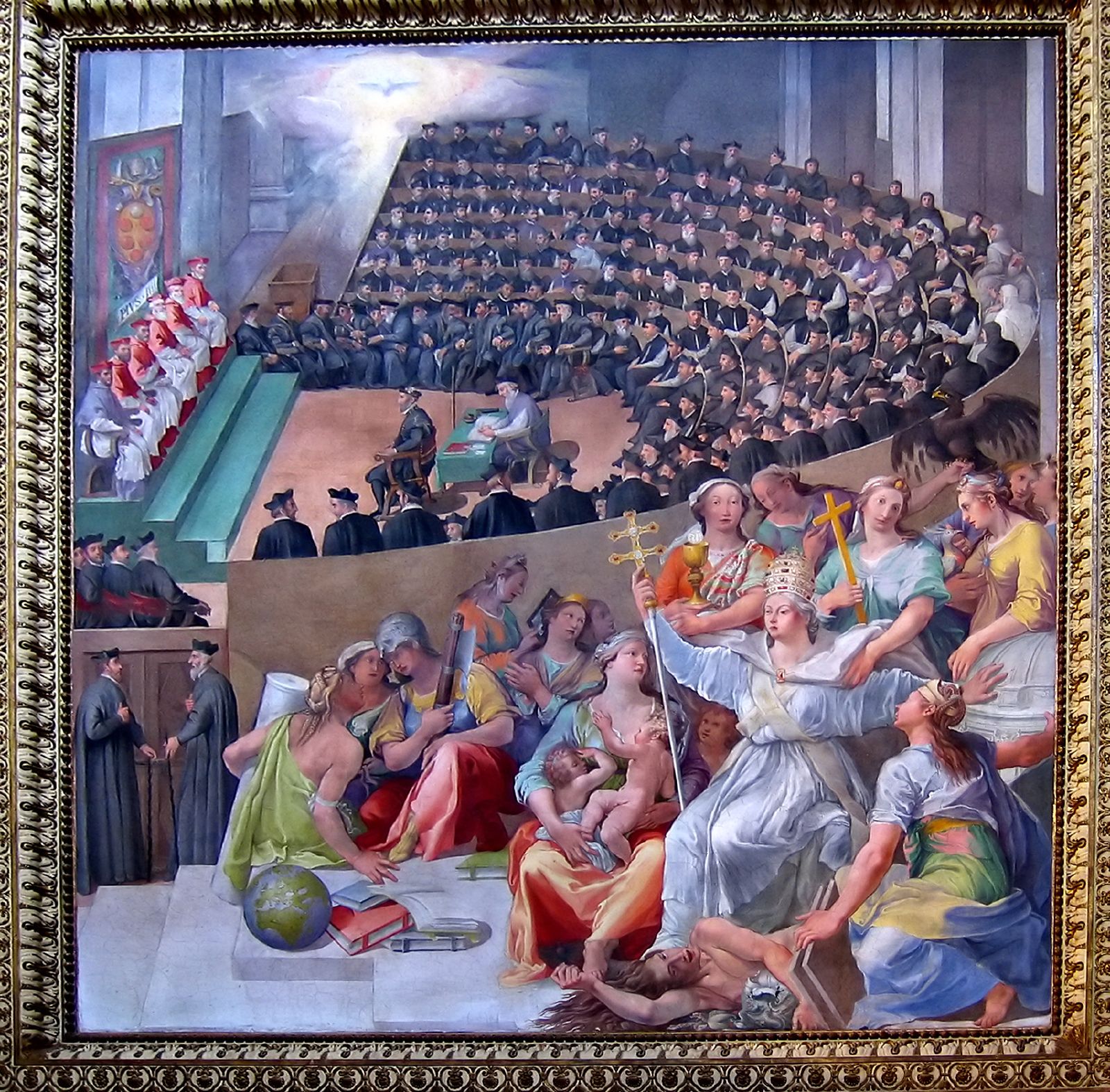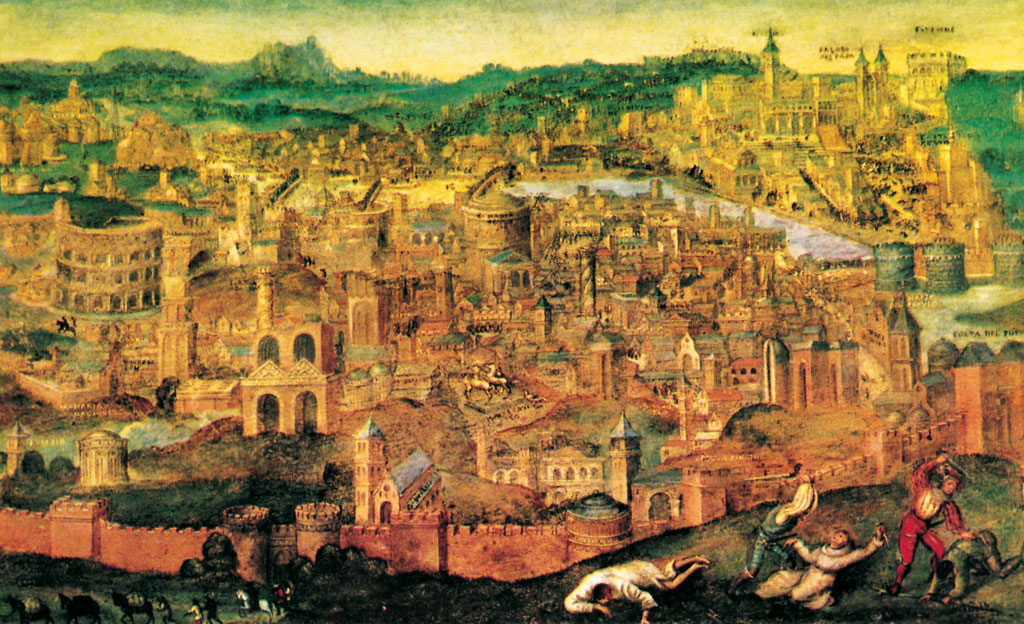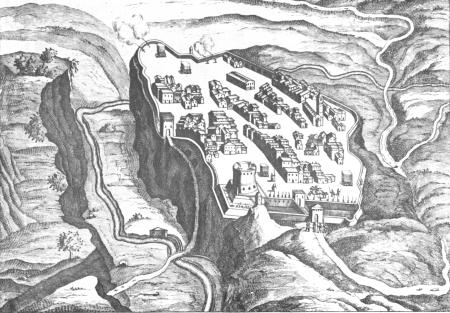|
Pope Paul III
Pope Paul III (; ; born Alessandro Farnese; 29 February 1468 – 10 November 1549) was head of the Catholic Church and ruler of the Papal States from 13 October 1534 to his death, in November 1549. He came to the papal throne in an era following the Sack of Rome (1527), sack of Rome in 1527 and rife with uncertainties in the Catholic Church as the Protestant Reformation progressed. His pontificate initiated the Catholic Reformation with the Council of Trent in 1545, and witnessed European wars of religion, wars of religion in which Emperor Charles V, Holy Roman Emperor, Charles V launched military campaigns against the Protestants in Germany. He recognized new Catholic religious orders and societies such as the Jesuits, the Barnabites, and the Congregation of the Oratory. His efforts were distracted by Nepotism#Origins, nepotism to advance the power and fortunes of his family, including his illegitimate son Pier Luigi Farnese, Duke of Parma, Pier Luigi Farnese. Paul III was a ... [...More Info...] [...Related Items...] OR: [Wikipedia] [Google] [Baidu] |
List Of Popes
This chronological list of the popes of the Catholic Church corresponds to that given in the under the heading "" (The Roman Supreme Pontiffs), excluding those that are explicitly indicated as antipopes. Published every year by the Roman Curia, the no longer #Numbering of popes, identifies popes by regnal number, stating that it is impossible to decide which pope represented the legitimate succession at various times. The 2001 edition of the introduced "almost 200 corrections to its existing biographies of the popes, from St Peter to John Paul II". The corrections concerned dates, especially in the first two centuries, birthplaces and the family name of one pope. The term ''Pope (word), pope'' () is used in several churches to denote their high spiritual leaders (for example Coptic pope). This title is usually used in English to refer to the head of the Catholic Church. The Catholic pope uses various titles by tradition, including , , and . Each title has been added by unique ... [...More Info...] [...Related Items...] OR: [Wikipedia] [Google] [Baidu] |
Cardinal-Bishop Of Frascati
The Diocese of Frascati (Lat.: ''Tusculana'') is a Latin suburbicarian see of the Diocese of Rome and a diocese of the Catholic Church in Italy, based at Frascati, near Rome. The bishop of Frascati is a Cardinal Bishop; from the Latin name of the area, the bishop has also been called Bishop of Tusculum. Tusculum was destroyed in 1191. The bishopric moved from Tusculum to Frascati, a nearby town which is first mentioned in the pontificate of Pope Leo IV. Until 1962, the Cardinal-Bishop was concurrently the diocesan bishop of the see. Pope John XXIII removed the Cardinal Bishops from any actual responsibility in their suburbicarian dioceses and made the title purely honorific. Relationships during the 17th century Like other dioceses close to Rome, Frascati became a bishopric of choice for Cardinals of powerful papal families during the 17th century; a period known for its unabashed nepotism. Frascati Bishops of that era were significantly intertwined: * Odoardo Farnese (1624–16 ... [...More Info...] [...Related Items...] OR: [Wikipedia] [Google] [Baidu] |
Council Of Trent
The Council of Trent (), held between 1545 and 1563 in Trent (or Trento), now in northern Italy, was the 19th ecumenical council of the Catholic Church. Prompted by the Protestant Reformation at the time, it has been described as the "most impressive embodiment of the ideals of the Counter-Reformation.""Trent, Council of" in Cross, F. L. (ed.) ''The Oxford Dictionary of the Christian Church'', Oxford University Press, 2005 (). It was the last time an ecumenical council was organized outside the city of Rome. The Council issued key statements and clarifications of the Church's doctrine and teachings, including scripture, the biblical canon, sacred tradition, original sin, justification, salvation, the sacraments, the Mass, and the veneration of saintsWetterau, Bruce. ''World History''. New York: Henry Holt and Company, 1994. and also issued condemnations of what it defined to be heresies committed by proponents of Protestantism. The consequences of the council were als ... [...More Info...] [...Related Items...] OR: [Wikipedia] [Google] [Baidu] |
Catholic Reformation
The Counter-Reformation (), also sometimes called the Catholic Revival, was the period of Catholic resurgence that was initiated in response to, and as an alternative to or from similar insights as, the Protestant Reformations at the time. It was a comprehensive effort arising from the decrees of the Council of Trent. As a political-historical period, it is frequently dated to have begun with the Council of Trent (1545–1563) and to have ended with the political conclusion of the European wars of religion in 1648, though this is controversial. However, as a theological-historical description, the term may be obsolescent or over-specific: the broader term Catholic Reformation () also encompasses the reforms and movements within the Church in the periods immediately before Protestantism or Trent, and lasting later. The effort produced apologetic and polemical documents, anti-corruption efforts, spiritual movements, the promotion of new religious orders, and the flourishing of ... [...More Info...] [...Related Items...] OR: [Wikipedia] [Google] [Baidu] |
Protestant Reformation
The Reformation, also known as the Protestant Reformation or the European Reformation, was a time of major theological movement in Western Christianity in 16th-century Europe that posed a religious and political challenge to the papacy and the authority of the Catholic Church. Towards the end of the Renaissance, the Reformation marked the beginning of Protestantism. It is considered one of the events that signified the end of the Middle Ages and the beginning of the early modern period in Europe. The Reformation is usually dated from Martin Luther's publication of the '' Ninety-five Theses'' in 1517, which gave birth to Lutheranism. Prior to Martin Luther and other Protestant Reformers, there were earlier reform movements within Western Christianity. The end of the Reformation era is disputed among modern scholars. In general, the Reformers argued that justification was based on faith in Jesus alone and not both faith and good works, as in the Catholic view. In the ... [...More Info...] [...Related Items...] OR: [Wikipedia] [Google] [Baidu] |
Sack Of Rome (1527)
The Sack of Rome, then part of the Papal States, followed the capture of Rome on 6 May 1527 by the mutiny, mutinous troops of Charles V, Holy Roman Emperor, during the War of the League of Cognac. Charles V only intended to threaten military action to make Pope Clement VII come to his terms. However, most of the Imperial Army (Holy Roman Empire), Imperial army (14,000 Germans, including Lutherans, 6,000 Spaniards and some Italians, Italians) were largely unpaid. Despite being ordered not to storm Rome, they broke into the scarcely defended city and began looting, killing, and holding citizens for ransom without any restraint. Clement VII took refuge in Castel Sant'Angelo after the Swiss Guard were annihilated in a delaying rear guard action; he remained there until a ransom was paid to the pillagers. Benvenuto Cellini, eyewitness to the events, described the sack in his works. It was not until February 1528 that the spread of a plague and the approach of the League forces unde ... [...More Info...] [...Related Items...] OR: [Wikipedia] [Google] [Baidu] |
His Holiness
The title His Holiness (and the associated form of address Your Holiness) is an official title or style referring to the pope in the Catholic Church; this use can be traced back several hundred years. It has also been adopted as an official title for other leaders in a number of religious traditions. It is used to refer to Oriental Orthodox patriarchs, and used to refer to religious leaders in Islam, Buddhism, and Bon. Buddhist leaders referred to this way include the Dalai Lama, the Menri Monastery, Menri Trizin, among others; the Da'i al-Mutlaq of the Dawoodi Bohras is one example of a Muslim leader styled this way. Buddhism and Bon The English-language honorific "His Holiness"(Burmese language, Burmese: အရှင်သူမြတ်ဘုရား; Ashin Thumyat Phya and the female version "Her Holiness" have commonly and very recently been used for religious leaders from other traditions, including Buddhism leaders such as the Thanlyin Mingyaung Sayadaw, Ashin Nandamā ... [...More Info...] [...Related Items...] OR: [Wikipedia] [Google] [Baidu] |
Silvia Ruffini
Silvia Ruffini (1475 – 6 December 1561 in Rome) was an Italian noble woman and mistress of Cardinal Alessandro Farnese before he became pope (Pope Paul III from 1534); she was the mother of his four children. Biography She was the daughter of Rufino Ruffini and Giulia (last name unknown), who lived in a palace in the Colonna neighbourhood of Rome. She had four brothers, Giacomo, Girolamo, Ascanio and Mario, and two sisters, Camilla and Ippolita. At some time around 1496 she married a Roman merchant named Giovanni Battista Crispo, with whom she had three sons: Sallustio, Virgilio and Cardinal Tiberio Crispo. Her husband died in 1501; she may already have been romantically involved with Cardinal Farnese by then. Ruffini was introduced to Alessandro Farnese by his sister Giulia (mistress to Pope Alexander VI), and the cardinal offered to be her escort through Rome. Their first daughter, Costanza, was probably born already in 1500. Ruffini had three other children with the ca ... [...More Info...] [...Related Items...] OR: [Wikipedia] [Google] [Baidu] |
Costanza Farnese
Costanza Farnese (19 December 1500 – 23 May 1545) was a daughter of Alessandro Farnese and Silvia Ruffini. Born before her father became Pope Paul III, her siblings were Pier Luigi, Paul, Ranuccio and Lucrezia. She married Bosio II Sforza, count of Santa Fiora e Cotignola, they had: * Guido Ascanio * Alessandro Sforza * Sforza Sforza, whose children were: ** Francesco Sforza Francesco I Sforza (; 23 July 1401 – 8 March 1466) was an Italian condottiero who founded the Sforza dynasty in the duchy of Milan, ruling as its (fourth) duke from 1450 until his death. In the 1420s, he participated in the War of L'Aqui ... ** Alessandro, 7th count of Santa Fiora, duke of Seni and prince of Valmontone, father of cardinal Federico Sforza. ** Costanza Sforza * Mario (1530–1591), count of S. Fiora, married Fulvia Conti * Faustina Sforza, married Muzio Sforza of Caravaggio * Francesca Sforza, married Girolamo Orsini * Camilla, married Besso Ferrero of Masserano References ... [...More Info...] [...Related Items...] OR: [Wikipedia] [Google] [Baidu] |
Ranuccio Farnese (1509–1529)
Ranuccio Farnese (1509–1529) was the natural son of Alessandro Farnese by Silvia Ruffini, born before his father was elected pope as Paul III. His siblings were Pier Luigi, Paolo and Costanza. External linksRanuccio on the Farnese family tree 1509 births 1529 deaths Ranuccio Papal family members Illegitimate children of popes {{Italy-noble-stub ... [...More Info...] [...Related Items...] OR: [Wikipedia] [Google] [Baidu] |
Pier Luigi Farnese, Duke Of Parma
Pier Luigi Farnese (19 November 1503 – 10 September 1547) was the first Duke of Castro from 1537 to 1545 and the first Duke of Parma and Piacenza from 1545 to 1547. He was the illegitimate son of Cardinal Alessandro Farnese (who later became Pope Paul III). He became a soldier and participated in the sack of Rome in 1527. Youth Pier Luigi Alessandro Farnese, born in 1503, was the son of Cardinal Alessandro Farnese and Silvia Ruffini. His father would be elected Pope Paul III on 13 October 1534. In July 1505, Pope Julius II legitimated Pier Luigi so that he could inherit the Farnese family estates. On 23 June, 1513, Pope Leo X published a second legitimation of Pier Luigi. In spite of the legitimations, his illegitimacy tormented Pier Luigi all his life, and doubtless contributed to the formation of his character. The nobility of Piacenza was frequently known to insult him as "the bastard son of the Pope." He was given a famous humanist tutor, Baldassarre Malosso di Casa ... [...More Info...] [...Related Items...] OR: [Wikipedia] [Google] [Baidu] |
Cardinal-Bishop Of Ostia
The Roman Catholic Suburbicarian Diocese of Ostia is an ecclesiastical territory located within the Metropolitan City of Rome in Italy. It is one of the seven suburbicarian dioceses. The incumbent bishop is Cardinal Giovanni Battista Re. For centuries, its bishop has been the dean of the College of Cardinals. Its Cathedral is Basilica di Sant'Aurea. From 1105 to 1914, the diocese was merged with the Suburbicarian Diocese of Velletri. In 1962, the Diocese of Ostia was brought under the direct administration of the Diocese of Rome. Its territory is restricted to the single parish of Santa Aurea. Bishops Bishops of Ostia (−1057) * Maximus (259) :... *Maximus (313) *Florentius (366) :''...'' *Bonus (487). *Bellator (499) *Aristus (502) :... *Amabile (649) :... *Andrea(s) (680) :... *Sissinio 732 – before 745 *Theodorus (745) * George I, 753–786 :''...'' * Gregory I, 787 – before 804 * Bernard 804–805 * Peter I 805 – before 826 * Cesareo 826–854 * Megisto (or Leo I), ... [...More Info...] [...Related Items...] OR: [Wikipedia] [Google] [Baidu] |






